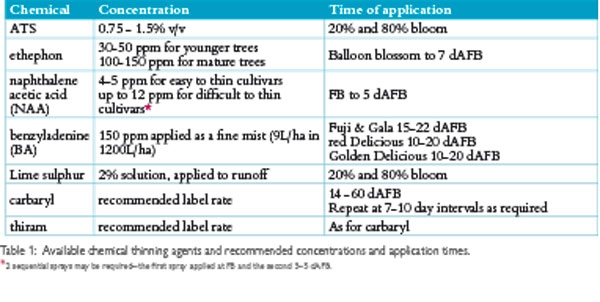(Continued from last month) Stages in the thinning program: 1. Pruning
Pruning during the dormant period should be considered the first stage of any thinning program. Well sized, high quality fruit are associated with open, healthy trees.
In apples, the best fruit occurs on younger spurs (2–4 year old). Canopies need to be opened up and trees kept young by appropriate pruning so that older spurs are removed and fruiting occurs on young wood.
Adequate light is also important for production of good quality fruit and initiation of strong flower buds—this is especially important in netted canopies.
Heading back of limbs should be avoided as this tends to invigorate the tree, instead, larger unbalanced branches should be removed completely.
Aiming for 6–7 branches per metre of tree height will open up the tree, resulting in improved bud initiation and better fruit quality as well as better spray penetration and access for harvesting.
Tying down upright branches will also help to calm trees.
The timing of pruning also has an effect on fruit quality. Tasmanian studies have shown that delaying dormant pruning until spring adversely impacts on fruit skin finish, sugar content and fruit shape.
Summer pruning is a common practice in Australian orchards to remove current season’s growth to prevent shading of the fruit and improve fruit colour. However, this practice has been shown to reduce fruit size and sugar content and produce flatter fruit—probably due to reduced photosynthate production resulting from the reduction in leaf:fruit ratio caused by summer pruning.
2. Chemical thinning
A program combining both bloom and post-bloom chemical thinners will give the most reliable results.
Remember that the chemical thinning program needs to start early in the flowering period using the chemical(s) of your choice. We are fairly lucky in Australia with a choice of chemicals available.
Registered blossom thinners are: ATS (ammonium thiosulphate), ethephon, or NAA.
Lime sulphur has also been shown to be effective as a blossom thinner.
There are two post-bloom thinners registered in Australia: 6-benzyladenine and carbaryl/thiram.
Continued next month
For more information, see Tree Fruit August 2014






















